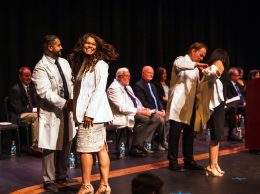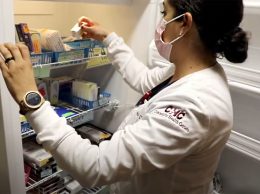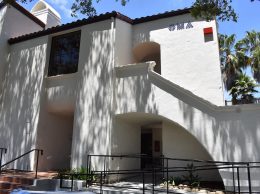Tri-Counties at center of critical doctor deficit
IN THIS ARTICLE
- Top Stories Topic
- Dana Olsen Author
By Dana Olsen Friday, November 4th, 2011
The Tri-Counties is among the most affected regions as California suffers from a statewide physician shortage that’s expected to become more critical as the years go by.
In the epicenter of the crisis are the cities of Santa Barbara and Lompoc, which are both having trouble attracting and retaining primary care physicians — but for very different reasons.
The California Health Care Foundation said there are 54 primary care physicians per 100,000 residents in the Tri-Counties; the recommended supply is 60 to 80. Meanwhile, there are 112 specialists per 100,000 residents, a number well above the recommended 85 to 105. And doctors across the county say the numbers reflect a growing problem.
The entire country is experiencing shortages in primary care, but there are a number of reasons why the problem is especially pronounced in California. The entire population is growing older, and California has the oldest physician work force of any state, with 30 percent of active doctors over 60 years old. That means more people need medical care and less people are available to give it.
Then there’s the state’s extremely high cost of medical malpractice insurance (up to $90,000 per physician per year) and the fact that California has the second highest cost of living in the United States. It’s particularly difficult for the state to attract primary care physicians because their salaries tend to be 30 percent less than those of specialists.
According to the CHCF report, the Central Coast is expected to bear the brunt of the primary care shortage.
U.S. Rep. Lois Capps, a Democrat from Santa Barbara and former nurse, said San Luis Obispo, Santa Barbara and Ventura counties are all experiencing shortages, and the problem isn’t just with doctors — the communities also need more nurses, physical therapists and hospice employees.
In Santa Barbara, primary care physicians and other health care professionals often don’t make enough money to support the high cost of housing. Stanley Frochtzwajg, chief medical officer of Community Memorial Health System in Ventura, said the reasons for Ventura’s primary care shortage mirrors those that plague Santa Barbara. But the more modest lifestyle in a semi-rural area like Lompoc can also deter doctors.
Dr. Marjorie Newman, assistant medical director of Sansum Clinic, said the explanation for the Santa Barbara shortage is a numbers game: “There are fewer doctors going into primary care because they come out of medical school with a lot of debt and want to enter specialties that pay more. Then they determine where they want to live, and it’s very difficult to recruit to Santa Barbara because of the high cost of living.”
It’s less expensive to live in Lompoc, but northern Santa Barbara County has its own troubles. Lompoc Valley Medical Center CEO Jim Raggio said Santa Barbara’s high home prices are advantageous for attracting doctors to the Lompoc medical center, as is the fact that it’s a brand new facility. But many physicians overlook Lompoc because of the small-town lifestyle and its lack of an organized employment system.
“The biggest problem for a rural hospital is that there is no set model. The lion’s share of physicians want an employment model, where they can just enter a clinic, put on a stethoscope and go to work,” Raggio said. “We’re hampered in Lompoc because we don’t have that.”
Raggio said everyone in the medical field acknowledges that there’s a physician shortage, but Central Coast hospitals are poised to tackle the problem.
The Sansum Clinic is one of the few health care providers in the region that directly hires physicians. Hospitals like Cottage Hospital in Santa Barbara and Marian Medical Center in Santa Maria don’t employ physicians; rather, they grant private physicians hospital privileges.
Sansum’s Newman said that despite the high cost of living, the clinic attracts physicians to Santa Barbara because it provides a built-in infrastructure for doctors to practice medicine.
“Especially nowadays, with the uncertainty of health care, many physicians coming out of training are looking for the system we have,” Newman said. “You don’t get a business degree in medical school; you want to take care of patients. We have a large entity that does that for you.”
According to Raggio, Lompoc’s medical center has been trying to set up a Sansum-type model for years. For now, though, the center is relying on recruiting doctors who prefer small-town life. The center has recruited an orthopedic surgeon, two general surgeons and a gastroenterologist to set up shop in Lompoc, but the search is far from over.
Marian Medical Center is trying something different. Chuck Cova, Marian’s president, said the hospital has more trouble recruiting primary care physicians than specialists, which he attributes to the simple fact that primary care doctors make less money. Marian’s answer to the primary care shortage is a family medicine residency program. The hospital is currently working with a few major medical schools to establish such a residency at Marian, and it’s set to open in 2014.
“That will allow us to bring in family practice residents, and we believe a number of them will stay on in Santa Maria,” Cova said.
Ventura County Medical Center already has a family medicine residency program, which CMHS’ Frochtzwajg said does draw primary care physicians to the area — but many of them leave when they complete residency because of the cost of housing.
For rural areas with physician shortages, the federal government has stepped in. A report from the U.S. Health Resources and Services Administration identifies Guadalupe, Orcutt, Paso Robles, Lompoc and Oxnard as areas in need of better access to primary medical care, dental care and mental health care.
In response, the government instituted the National Health Service Corps, a program designed to attract primary care physicians to underserved areas. So far, the program has awarded $900 million in scholarships and loan repayment to health care professionals across the country. In California, 537 doctors have received financial incentives to become primary care physicians.
Capps said the program is one way to alleviate the health care crisis along the Central Coast. “The federal government is hugely involved in the problem of doctor shortages. The program has tripled in the past three years because once the new health care law is completely rolled out, everyone will have access to health care,” Capps said. “The program rolls out in Washington, D.C., but I’ve seen its effects locally. Clinics in Santa Barbara and San Luis Obispo, for example, have been able to extend their hours, making health care much more accessible.”
As of 2008, there were 119,000 physicians with active California medical licenses, according to the Medical Board of California. Just 66,500 of those physicians actively practice medicine 20 hours or more per week — and of those, 34 percent provide primary care.
In 1980, the Graduate Medical Education National Advisory Committee projected an oversupply of physicians by the year 2000. In response, medical schools capped enrollment and the federal government froze funding for residency training.
Now, experts are projecting a shortage of 17,000 physicians in California by 2015.
Related Articles
 Friday, September 16th, 2022
Friday, September 16th, 2022









